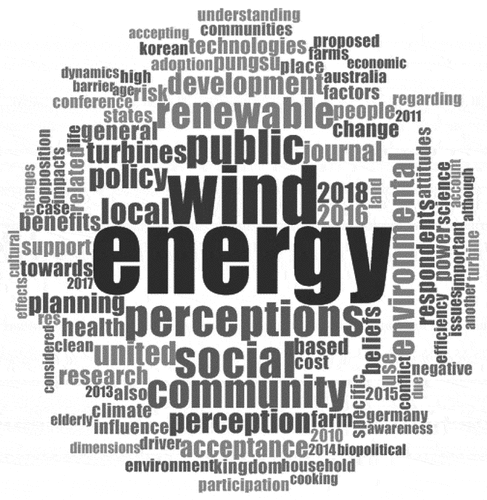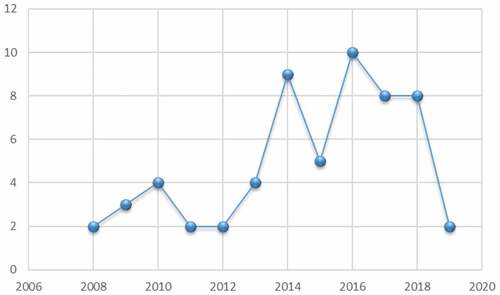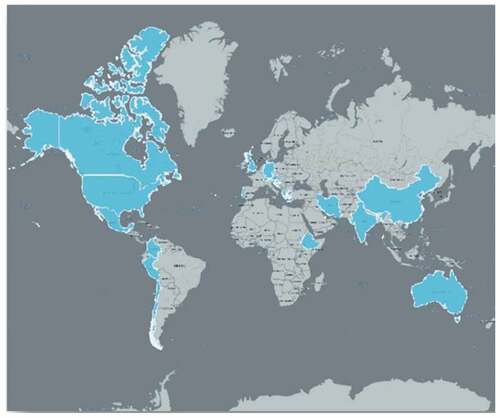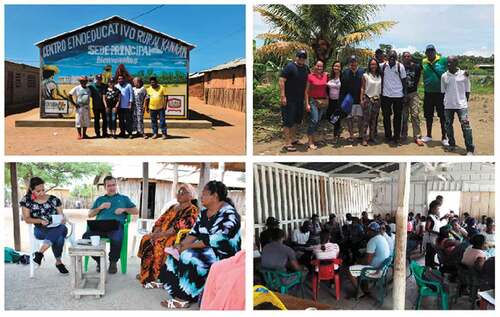Abstract
Renewable energy projects are being developed and implemented in different geographical areas of several continents. In each of them, many communities develop their lives that have cultural, social and environmental potentials; as well as perceptions, beliefs and criteria for the acceptance of renewable energy projects in their territories. Through the methodology of mapping SCOPUS articles published worldwide, this work examines the perceptions, beliefs and criteria of community acceptability against renewable energy projects that are based on the use of natural resources such as sun, water, wind, earth, and biomass. These perceptions and beliefs can come from ancestral traditions that mark the relationship of communities with beings of nature and not with natural resources, which is the modern vision. Other perceptions, beliefs and criteria of acceptability in non-ancestral communities may be related to risk perception, low levels of trust and credibility between stakeholders, confusion regarding the operation of renewable energy systems, among others. Whatever their origin, the experience in implementing these projects has taught about the relevance of involving communities during the stages of their development, the need to know the different places from where their worlds are explained and thus improving the levels of relevance, acceptance, and sustainability of renewable energy systems.
PUBLIC INTEREST STATEMENT
Renewable energy projects are being developed and implemented in different geographical areas of several continents. In each of them, many communities develop their lives that have cultural, social and environmental potentials; as well as perceptions, beliefs and criteria for the acceptance of renewable energy projects in their territories. This work examines the perceptions, beliefs and criteria of community acceptability against renewable energy projects that are based on the use of natural resources such as sun, water, wind, earth, and biomass. These perceptions and beliefs can come from ancestral traditions that mark the relationship of communities with beings of nature and not with natural resources, which is the modern vision. Other perceptions, beliefs and criteria of acceptability in non-ancestral communities may be related to risk perception, low levels of trust and credibility between stakeholders, confusion regarding the operation of renewable energy systems, among others.
1. Introduction
In recent years, the human being has understood that the intensive, permanent and prolonged use of non-renewable resources for obtaining energy is an unsustainable alternative on planet Earth, due to the increase in energy needs, the important repercussions on the environment and the near scarcity of resources so far used, such as fossil fuels. The awareness of the need to find other sources and strategies to obtain energy is growing. The human being also comes to understand that the possibilities of supplying their energy needs, must guarantee the coverage of current needs, as well as the future supply of next generations and that this is feasible to achieve, yes and only if the resources are renewed naturally and permanently. For this reason, the characteristics of certain natural resources, coupled with the scientific and technological advances of the human beings are allowing elements that have accompanied the passage of man on the planet Earth since the beginning and are currently visible as sources of energy, feasible transform and turn into the resource that is required for the multiplicity of uses that human beings gives it. Among these resources are water, wind, sun, soil.
The discovery and use of fossil fuels has helped in the evolution of human society, from agricultural civilization to industrial civilization. Likewise, it has caused serious environmental problems. The earth is calling for a sustainable future, and the change from industrial civilization to ecological civilization based on the new energy revolution (Xiangwan, Citation2015, p. 115).
Different populations in many countries have been developing and implementing projects based on the use of these resources, with various technologies for the production of energy through renewable sources.
However, for more promising than the implementation of mentioned projects may be for certain groups of people. It is not possible to ignore that human beings inhabit the territories where natural resources are found and the link to these territories; there are countless social and cultural experiences, which give specific meanings to the existence and relationship of the human beings with the different elements of the nature, (Sposato & Hampl, Citation2018). This way being, the sense and practices that human beings realizes with the sun, wind, water, and soil, possess a set of meanings that depend on the forms of life, cosmovisions, territorial perceptions in the communities where the projects are launched. (Bidwell & Affairs, Citation2016). These worldviews may not always coincide with the vision of energy production through renewable sources and may require dialogue from various ways of understanding and experiencing the situation of using natural sources such as sun, wind, water and soil.
The objective of the present study is to carry out a mapping study of the scientific articles that have currently addressed this topic. Foregoing with the intention that this allows to know the state of the research about the perceptions, beliefs and levels of acceptance that communities of rural areas or non-interconnected areas, are demonstrating, in front of the implementation of energy renewable projects. Foregoing in order to understand various community encounters and disagreements on the subject; as well as the strategies and relevant aspects to be analyzed, when it comes to implementing renewable energy. “The gap between the low acceptance of wind farms and the popularity of wind power in national opinion is the key issue in energy transition research” (Eun-Sung, Ji-Bum, & Yongseok, Citation2018, p. 262).
Next, the document presents the methodology followed to carry out the mapping of the information; it takes into account aspects such as the definition of the research questions, definition of the SCOPUS database for the search, search chains with keywords, criteria for inclusion and exclusion of articles. Subsequently, the presentation of the extracted data is carried out, so that they can answer each of the research questions in the results chapter. The present article ends with a discussion on the findings and recommendations for future studies and implementation of renewable energy projects.
2. Methodology
The present work is a mapping study of scientific articles, published between the years 2008 to 2019, with an objective of finding knowledge gaps related to perceptions, beliefs, levels of community acceptance regarding renewable energy initiatives, in different cultures and geographic spaces. The implementation of the methodology was developed with a work plan that included definition of research questions, of databases and search chains, identification of inclusion criteria and exclusion of the articles to be reviewed. Please refer to Tables –.
Table 1. Research question
Table 2. Data base definition and search Chain
Table 3. Keywords used
Table 4. Inclusion and exclusion criteria
The search of the articles was done in two ways, automatically and manually; initially, through automatic search in SCOPUS database, making use of the keywords and search chains previously defined. Subsequently, a manual search, based on the snowball approach, was carried out taking up articles related to those identified automatically. The selection of articles was made taking into account inclusion and exclusion criteria defined in terms of type of document, quality of articles, period of time of publication and area of knowledge.
Having identified the articles that met the selection criteria, we proceeded to review each of them, in light of the research questions identifying the aspects of the article that would respond to each of them.
The data extraction process from SCOPUS initially yielded 129 articles. A detailed review of the titles and their direct relationship with the subject of study reduced the number of articles to 52, of which 27 articles were retaken for further exploration. Please see Figure .
3. Results
Q1. How many articles have been published on issues of perceptions, beliefs and acceptability of communities regarding renewable energy projects between 2008 and 2019?
Through the review of these articles shown in Figure , a progressive number of studies related to the perceptions, beliefs and acceptability of the communities have been identified in recent years, as well as the growing renewable energy projects in various geographical areas. The 78% of the articles included in this figure have been produced between 2013 and 2019. It can be seen that despite the relevance that has already been given to renewable energy projects since previous years, the community dimension, perceptions and beliefs that affect the acceptability and sustainability of projects, was a small explored issue, leading to the slowdown in the achievement of proposed goals in terms of the integration of other renewable energy resources in different countries. For example, in England during the period between June 1999 and May 2000, only 24,8% of planning applications for wind farms had been accepted, with 26,6% rejected and 41% under inquiry (Reniew, 2012, cited by Devine-Wright, Citation2005). After understanding the vision, knowledge, behavior of the people in front of the implementation of renewable energy projects in their territories and for their daily use, constitutes a key factor for the development and sustainability of the same, the studies with a participative and comprehensive approach of the communities have increased noticeably.
Regarding the studies that have been chosen to carry out the recent review, in 2008 there are two works, one of them directed towards the attitudes of the community and the other regarding the perceptions of renewable energy opportunities locally. In 2009, three studies were obtained on the subjects of attitudes, acceptability and perception of the environmental impact. For the year 2010, we have four records focused on the perceptions, acceptability and understanding of the community regarding renewable energy issues. Between the years, 2011 and 2012, three studies are obtained oriented towards the acceptance of the communities. From the year 2013 and continuing, studies on these topics have maintained an upward trend; this shows the increase in renewable energy projects and the experiences gained through their implementation with the active participation of the communities. (Howell, Citation2018)
The studies reviewed mostly focus on the beliefs, perceptions and acceptability of projects related to renewable energies in general terms. Second, there are specific studies on the beliefs, perceptions and acceptability of wind farm projects, solar energy and biomass.
Q2. Where have these investigations been carried out?
The map in Figure shows the diversity of geographical areas where studies on perceptions, beliefs and acceptability of renewable energy initiatives are being carried out. In the American continent, the United States leads the production of these studies with 12,5% of research, followed by Canada and Mexico covering 7,14% each. With regard to countries such as Colombia and Chile 3,6% of the articles are counted and 1,8% Peru, for 35,8% of the studies. The European continent covers the largest number of articles produced on the subject with 46,7% distributed among the United Kingdom 25,2%, Greece 8,9%, Switzerland 3,6% and in turn Austria, Croatia, Denmark, Germany, Mediterranean Islands and Portugal 1,8% each. With regard to the Asian continent, articles from India are of a 3.6% while China, Iran, Korea and Qatar of a 1,8% each. On the African continent, Ethiopia has 1,8%. At the same time in Oceania, specifically in Australia, 5,0% of the articles included in the present mapping are counted.
This outcome demonstrates the comprehension of global character that has been reached by governments, individuals, industry, communities, academy, among others, regarding the imminent need of transition from fossil energies to energies renewable and especially the relevance of cultural, psychological, educational, and economic, in complementarity with those factors of a technical and technological nature.
Since 2000 the Millennium Development Goals have been marking a course of action for all those involved in the sustainability of the planet, that is to say for all, and although they did not directly define goals in terms of capacity and diversity of energy sources, it was implicit that the achievement of the goals proposed at that time demanded a diverse, growing and stable energy capacity in the different geographical areas, especially in the most remote of the urban centers. The Economic Commission for Latin America and the Caribbean (ECLAC) in its document on the contribution of energy services to the Millennium Development Goals and the alleviation of poverty in Latin America, affirms that “traditionally energy is still considered as a separate sector, establishing limited links between access to energy services and the achievement of national development goals of environmental protection and poverty reduction “.
Currently, the Sustainable Development Goals (SDGs) have made explicit the need to ensure energy production capacities in each region, no matter how isolated, and reduce the dependence of communities on conventional electrical systems. Each geographical area has an energy potential derived from its renewable natural resources. This makes knowledge of the communities and their social, cultural and environmental potentials, among others, indispensable.
Q3. What kinds of perceptions, beliefs or criteria of acceptability have been studied?
Regarding the human being, any type of transformation towards their ways of thinking, doing, feeling and experiencing the world goes through the revision of the ways of perceiving and granting socially constructed and insured meanings for the following generations through processes and practices culturally. The perception “is nuanced and restricted by the social demarcations that determine ranges of sensations on the margin of physical-corporal possibilities; thus, the real perceptual ability remains subjectively oriented towards what is socially “allowed” to perceive “.
The review of the articles has allowed to establish the following categories, from which it is possible to identify the perceptions, beliefs and acceptance criteria of renewable energy projects in the communities studied.
Shared understanding
Related to worldviews or perceptions and beliefs related to the origin of the world and the qualities of the beings of nature. Fears regarding the reactions of nature due to the unauthorized use of sacred territories and spiritual entities such as water, wind, and sun. What can cause diseases, natural catastrophes, destruction of the community? (Devine-Wright, Citation2005). Age plays an important role in this aspect since communities with an older population which are more linked to their ancestral knowledge will have greater difficulty accepting other visions and behaviours.
Reason for trust
Related to the distrust towards external actors to the community; unfortunate experiences with previous projects; and little knowledge about the operation of renewable energy systems. (Ambrosio-albalá, Upham, & Bale, Citation2019).
Reason for control
In this sense, research has addressed the issue in a more individual than community, among the identified reasons for control are knowledge, self-efficacy and the expectation of results. (Walsh, van Der Plank, & Behrens, Citation2017)
Attribution biases
Communities may consider their properties devalued as well as large tracts of land should be used. They project that the quality of life diminishes due to the change in landscapes, noise, pollution in zones that have been completely natural, vibration and other effects derived from the installation of machines or equipment. (Delicado, Figueiredo, & Silva, Citation2016; Howell, Citation2018; Jalali et al., Citation2016), Some consider that their source of livelihood can be affected by the decrease in fishing and tourism and damage to cultural heritage. (Garrido, Rodríguez, & Vallejos, Citation2015). However, it is emphasized in the imbalance of other environmental systems. Some of the studies reviewed emphasize the interest of people and communities for renewable energy, but the disinterest in being installed in their territories, this under the concept “not in my yard”. (Stephanides et al., Citation2019). On the other hand, governments and communities have not established the relationship between poverty and lack of energy. (Bouzarovski & Petrova, Citation2015).
Motivational psychology frameworks
These frameworks have been used effectively in different manners to increase the user participation: 1. For energy trading design leading to a decrease of carbon emissions by 18.38% and 9.82% in a single day in summer and winter respectively compared to a feed-in-tariff scheme (Tushar et al., Citation2019). 2. For design of an energy management technique applied to the air-conditioning (AC) systems use in residential buildings (Tushar et al., Citation2018). The applied framework led the consumers to accept the technology that reduces electricity consumption, the cost of electricity, peak power from the grid; and the generation of CO2 in the residential building.
Policy impacts
As people change their vision towards the environment, more public renewable energy policies become necessary where human rights can add social values to energy governance (Anderson, Böhmelt, & Ward, Citation2017). To guarantee greater success in the energy transition, public energy policies must be integrated with those of transport, environment, territorial plan, among others, aiming at common goals and building consensus platforms to guarantee the continuity of the programs, instead of each sector creates isolated objectives.
4. Discussion
In accordance with the research questions established for the present mapping, it is observed that research on community perceptions and beliefs and their relationship with the conditions of acceptability of projects have been positioned as a focus of interest in the context of energy renewable research, highlighting the need for an interdisciplinary view given the complexity of the subject.
The above is very coherent if one takes into account that this kind of projects, go beyond an innovation or technological solution to globalizing human problems. The issues related to renewable energies touch the sensitive fibers of the communities where the projects are necessarily implemented. On the one hand, because the raw material of their actions corresponds to highly valued natural resources, whether from a magical-religious, environmental, political or economic point of view; on the other hand, because it implies transformations, not only regarding the use of energy sources, but also against the vision that has been perceived about the world and the way we coexist in it.
The present review has shown that the United Kingdom has been one of the leading countries in this type of research, as well as United States, highlighting the importance of knowing and working on the perceptions and beliefs of the populations about renewable energy projects to address some barriers in the acceptance process of said projects by the communities. Weber (Citation2002) refers to this process as the search for an understanding of the meaning of human action for the explanation of social processes.
On the other hand, a broad view regarding the studies reviewed allows us to identify that some of them have been focused on an individual level through the study of aspect related to human social cognition. (Komendantova, Yazdanpanah, & Shafiei, Citation2018). As well as other articles have addressed the issues from a broader social level, in which social action is played in political, economic, cultural issues of the populations analyzed. Social cognition, for its part and task of understanding how cognitive processes influence human social interaction is related to concepts such as beliefs, perceptions and social representations, which are nuanced by moral norms or socially constructed values. The recent review has shown how many studies with different approaches and populations have resumed values as a predictor of the acceptance or not of renewable energy projects, as appropriate for the different populations.
Likewise, psychological factors such as self-efficiency and self-gratification are significant when taking into account that various studies which have shown that fear of change is a relevant factor for the acceptance of renewable energy projects; the change tends to decrease with the tendency to keep traditions, beliefs, pre-established norms (Marciano, Lilieholm, Teisl, Leahy, & Neupane, Citation2014). In addition, among these factors it is possible to include trust and credibility in other people, an aspect that stands out in the studies reviewed.
Sociodemographic aspects have a high psychosocial component; it has been notorious in several studies. (Johansen & Emborg, Citation2018) Communities with older members or that are strongly linked to their traditions, beliefs and ancestral values, have shown greater difficulty in appreciating other points of view of renewable energy projects. (Eun-Sung et al., Citation2018). These communities, in turn, may harbor fears about their self-efficency in the adoption of new technologies, values, and ways of life; with also very low levels of self-gratification. On the other hand, the youngest population has greater confidence in their self-efficiency and greater expectations of self-gratification regarding renewable energy projects. (Komendantova et al., Citation2018).
5. Conclusions
The results allow concluding that when considering renewable energy solution within a community, the following should be considered:
The perceptions and beliefs of communities and individuals exert an important influence on the acceptance or not of renewable energy projects in various parts of the world. Therefore, it is advisable to reflect on the meaning of social action that predominates in a given community. This taking into account their sociodemographic composition, their style of rationality according to ends, according to values or traditions. Likewise, the influence of more individualistic or community visions. Their educational levels and presence of elements that make possible the transition and adjustment.
The relationship between the stakeholders must be based on the trust from beginning to end of the implementation of the projects.
The youngest population has socio-cognitive, cultural, psychological, and technological conditions to think of a world with a diversity of energy sources, with landscapes even more mixed with human technological developments. Likewise, they have greater access to information about the problems with the biggest sources of energy of the present and finally greater familiarity with the changes, the instability and the need for constant innovation since these are characteristics of the world in which they have developed his life.
It is possible to take into account that projects with solar energy, biomass and water sources have a higher level of acceptance than wind farm projects.
Acknowledgements
The authors are grateful to the project Identification of Knowledge Gaps in the Academy and Capacity Building for Aquatic Renewable Energy in Colombia sponsored by the Royal Academy of Engineering/Newton Fund.
Additional information
Funding
Notes on contributors

Ramón Fernando Colmenares-Quintero
Ramón Fernando Colmenares-Quintero is currently national head of research in engineering and Professor Dr. at the Universidad Cooperativa de Colombia (UCC) with research focus on energy generation, simulation and modelling in the energy sector and multi-objetive optimisation for renewable energy systems.
Juliana Maria Benavides-Castillo
Juliana Maria Benavides-Castillo is a social psychologist and works as a lecturer at the UCC. She has worked on projects related to the well-being of indigenous communities.
Natalia Rojas
Natalia Rojas has a degree in Civil Engineering and an MSc in Marine Renewables, Natalia brings knowledge and expertise in engineering to the Aquatera Team. She has also worked as a site manager and been in charge of various coastal constructions, leading teams of more than 30 people.
Kim E. Stansfield
Kim E. Stansfield got a PhD in Composites from Kingston University. He was sustainable energy systems transformation planner at the UK Energy Technologies Institute. Joined Warwick WMG in 2016 as lecturer.
References
- Ambrosio-albalá, P., Upham, P., & Bale, C. S. E. (2019). Purely ornamental? Public perceptions of distributed energy storage in the United Kingdom. Energy Research and Social Science, 48, 139–12. doi:10.1016/j.erss.2018.09.014.
- Anderson, B., Böhmelt, T., & Ward, H. (2017). Public opinion and environmental policy output: A cross-national analysis of energy policies in Europe. Environmental Research Letters, 11.
- Bidwell, D., & Affairs, M., 2016. Public acceptance of offshore wind energy: Relationships among general and specific attitudes, OCEANS 2015 - MTS/IEEE Washington.
- Bouzarovski, S., & Petrova, S. (2015). A global perspective on domestic energy deprivation: Overcoming the energy poverty-fuel poverty binary. Energy Research and Social Science, 10, 31–40. doi:10.1016/j.erss.2015.06.007
- Delicado, A., Figueiredo, E., & Silva, L. (2016). Community perceptions of renewable energies in Portugal: Impacts on environment, landscape and local development. Energy Research and Social Science, 13, 84–93. doi:10.1016/j.erss.2015.12.007
- Devine-Wright, P. (2005). Local aspects of UK renewable energy development: Exploring public beliefs and policy implications. Local Environment, 10(1), 57–69. doi:10.1080/1354983042000309315
- Eun-Sung, K., Ji-Bum, C. H., & Yongseok, S. (2018). Korean traditional beliefs and renewable energy transitions: Pungsu, shamanism, and the local perception of wind turbines. Energy Research and Social Science, 46, 262–273. doi:10.1016/j.erss.2018.07.024
- Garrido, J., Rodríguez, I., & Vallejos, A. (2015). Social responses to wind farm development: The case of the mar brava conflict in the great Island of Chiloé, Chile. Papers, 100(4), 547–575.
- Howell, R. A. (2018). UK public beliefs about fracking and effects of knowledge on beliefs and support: A problem for shale gas policy. Energy Policy, 113, 721–730. doi:10.1016/j.enpol.2017.11.061
- Jalali, L., Bigelow, P., MCcoll, S., Majowicz, S., Gohari, M., & Waterhouse, R. (2016). Changes in quality of life and perceptions of general health before and after operation of wind turbines. Environmental Pollution, 216, 608–615. doi:10.1016/j.envpol.2016.06.020.
- Johansen, K., & Emborg, J. (2018). Wind farm acceptance for sale? Evidence from the Danish wind farm co-ownership scheme. Energy Policy, 117, 413–422. doi:10.1016/j.enpol.2018.01.038
- Komendantova, N., Yazdanpanah, M., & Shafiei, R. (2018). Studying young people’ views on deployment of renewable energy sources in Iran through the lenses of Social Cognitive Theory. AIMS Energy, 6(2), 216–228. doi:10.3934/energy.2018.2.216.
- Marciano, J. A., Lilieholm, R. J., Teisl, M. F., Leahy, J. E., & Neupane, B. (2014). Factors affecting public support for forest-based biorefineries: A comparison of mill towns and the public in Maine, USA. Energy Policy, 75, 301–311. doi:10.1016/j.enpol.2014.08.016.
- Sposato, R. G., & Hampl, N. (2018). Worldviews as predictors of wind and solar energy support in Austria: Bridging social acceptance and risk perception research. Energy Research and Social Science, 42, 237–246. doi:10.1016/j.erss.2018.03.012.
- Stephanides, P., Chalvatzis, K. J., Li, X., Mantzaris, N., Prodromou, M., Papapostolou, C., & Zafirakis, D. (2019). Public perception of sustainable energy innovation: A case study from Tilos, Greece. Energy Procedia, 249–254. doi:10.1016/j.egypro.2018.12.058.
- Tushar, W., Saha, T. K., Yuen, C., Morstyn, T., McCulloch, M. D., Poor, H. V., & Wood, K. L. (2019). A motivational game-theoretic approach for peer-to-peer energy trading in the smart grid. Elsevier Applied Energy, 243, 10–20. doi:10.1016/j.apenergy.2019.03.111.
- Tushar, W., Yuen, C., Li, W. T., Smith, D., Saha, T., & Wood, K. L. (2018). Motivational psychology driven AC management scheme: A responsive design approach. IEEE Transactions On Computational Social Systems, 5, 289–301. doi:10.1109/TCSS.2017.2788922.
- Walsh, B., van Der Plank, S., & Behrens, P. (2017). The effect of community consultation on perceptions of a proposed mine: A case study from southeast Australia. Resources Policy, 51, 163–171. doi:10.1016/j.resourpol.2016.12.006
- Weber, M. (2002). Society and economy: An outline of interpretive sociology 31(1). Culture Economic Found.
- Xiangwan, D. (2015). Energy revolution: For a sustainable future. Chinese Journal of Population Resources and Environment, 13(2), 115–118. doi:10.1080/10042857.2015.1017906.




